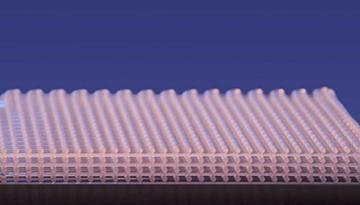Cellular silicone foams are commonly used as stress cushions in energy absorbing applications. These foams are used to distribute and relieve stress between adjacent parts, dampen shock and vibrations, maintain relative positioning of components, and mitigate the effect of component size variations due to manufacturing or temperature variations. However, the cellular silicone fabrication process is long, difficult and can result in poor material structure or with pores too large for some applications. And parts are limited to constant density; density variations or gradations are difficult. Consequently, there is a need for energy absorbing materials and fabrication methods which are engineered and designed with well-controlled structure and tailored bulk properties.
LLNL provides solutions to our nation's most important national security challenges through innovative science, engineering and technology. Researchers at LLNL have turned to advanced manufacturing techniques to solve a variety of materials limitations, including the need for tailored energy absorbing materials. Additive manufacturing, sometimes called 3D printing, is the process of building three dimensional structures by layering one material on top of another in a desired pattern. Additive manufacturing is being advanced by LLNL researchers to fabricate materials with 3D micro-architectures with sub-micrometer features. A material's properties can be altered to defy conventional behaviors by controlling the material's micro-architecture. By enabling the manufacture of 3D micro-architecture materials with novel properties, LLNL researchers are pushing the limits of additive manufacturing and material design and paving the way for a new generation of transformative products and applications.
To overcome limitations with cellular silicone foams, LLNL innovators have developed a new 3D energy absorbing material with tailored/engineered bulk-scale properties. The energy absorbing material has 3D patterned architectures specially designed for specific energy absorbing properties. The combination of LLNL's capabilities in advanced modeling and simulation and the additive manufacturing technique known as direct ink writing allowed LLNL researchers to design and control the material's compression properties with very small feature sizes. The fine control that direct ink writing provides to the manufacturing process further enables specialty properties where desired in the bulk material. Advantages include:
- Controlling directionally dependent properties, which further improves the ability of the material to meet differing applications requirements for mechanical compression versus shear;
- Different patterns for different regions of the bulk material, for selective properties in selected locations within the bulk material;
- Varying density/porosity over large range, varying density spatially in a single part, and varying mechanical response at constant porosity through the structure;
- Engineering anisotropy in the bulk mechanical properties;
- Designing the bulk material with non-planar surface contours which can conform to a 3D object.
LLNL's energy absorbing material may be fabricated with uniform pore structures and feature sizes down to about 100 micrometers or less. The material can be manufactured using curable siloxane resin base materials in particular, which may be desirable because they provide high flexibility and have no residual catalyst.
LLNL's energy absorbing materials may be used for:
- Distribution of stress between components
- Mitigation of vibration and shock,
- Maintenance of the relative positioning of adjacent components,
- Relief from dimensional changes due to thermal variations,
- Allowance for tolerances in the dimensions of other parts, and
- Absorbing impact, sound, vibration, or other types of energy.
Commercial products which could use the LLNL energy absorbing material may include footwear, sports/athletic gear, medical devices, helmets, safety equipment, equine equipment, mattresses, seats, automobile equipment, baby seats, arm rests, acoustically attenuating materials, and blast mitigating materials.


